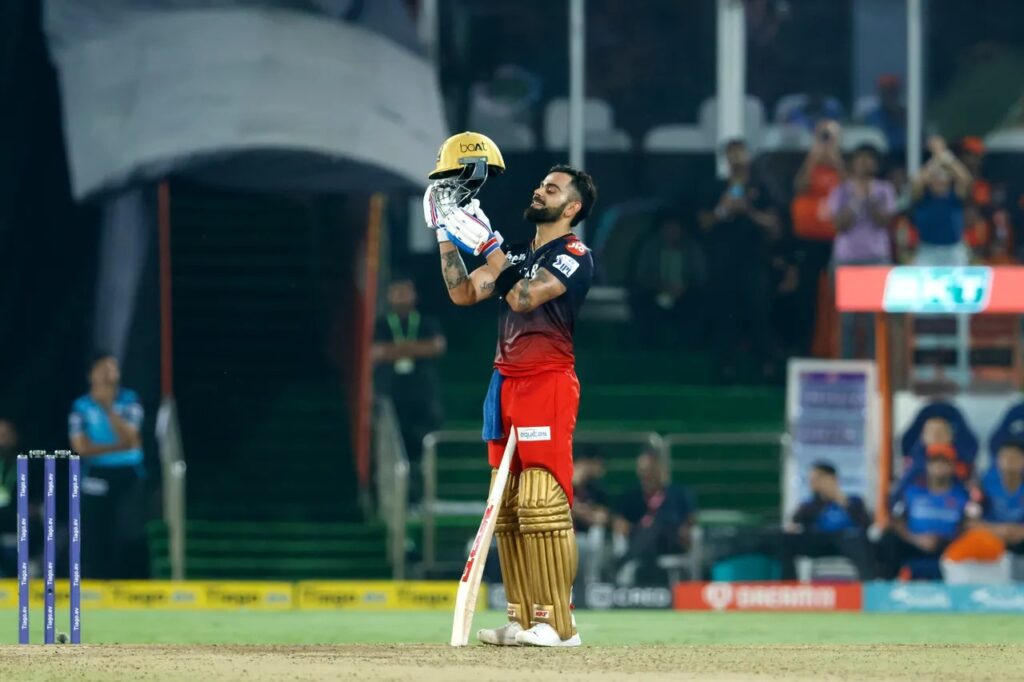
Virat Kohli’s dazzling century against Sunrisers Hyderabad was his first in the Indian Premier League (IPL) since 2019. It also took him past 500 runs in a season for the first time since 2018. After a run-drought in the pandemic years, the last few months have seen Kohli show glimpses of his old majesty across formats. So, what has changed? And what can we expect in the months ahead?
Quite a few folks in the media space love to go looking for technical flaws to explain a player’s recent struggles. Many of them would not even have played the game at club level, but it doesn’t stop them writing entire treatises on footwork or elbow position. That the player in question often has tens of thousands of runs to his name, and access to the best coaches and latest technology, is often overlooked.
Many years ago, when he was coaching India, Greg Chappell used to read or hear about some of these stories and laugh. Not just at the naivete of some of the analysis, but at the lack of understanding of how sport works at the highest level. Chappell used to love telling a story, of his own season of struggle in the early 1980s, when he could barely put bat to ball.
May 18, 2016 – #ViratKohli scored a brilliant ton v #PBKS.
May 18, 2023 – He repeated the feat against #SRH!
A superlative hundred from Kohli and his 172-run partnership with #duPlessis power #RCB to a crucial win.#ipl2023 #ipl pic.twitter.com/77gDPmxmpJ
— RevSportz (@RevSportz) May 18, 2023
After one such failure, Rudi Webster, who had played plenty of cricket himself before becoming a sports psychologist with the West Indies team, came to see him near the dressing rooms. One of the first things he asked Chappell was: “Are you watching the ball properly?”
“My first reaction was to punch him,” said Chappell with a smile many years later. “I’d played over a decade for Australia, scored hundreds against the best, and he was asking me if I watched the ball.” Seeing his expression, Webster added: “Don’t answer right away. Think about it. Are you really watching the ball?”
Webster’s point was a simple and crucial one. In cricket, especially when facing quality bowlers, you have a split-second to decide on a choice of shot and try and execute it. The tiniest delay means that that gorgeous cover-drive for four becomes a thick outside edge to the slip cordon.
“What Rudi tried to tell me was that my mind was cluttered,” said Chappell. “There were so many things weighing me down. Captaincy, lack of runs, being away from family for long periods. When you go out to bat with all of this on your mind, your focus isn’t only on the ball.”
In 2019, Kohli scored two centuries and averaged 68 from eight Tests. In the 50-overs game, where he led India to the World Cup semifinal in England, there were five centuries in just 25 innings. In the shortest format, he had made five scores over 50 in 10 T20Is and smashed 464 runs at a strike-rate of 141.46 in the IPL.
Then, the pandemic happened, and things fell apart. Did technical glitches creep in? Did he lose focus? Or were the reasons much more prosaic?
No man is an island, and none of us can live in some cocoon. It was fairly early into the first lockdown in 2020 that Kolhi and his wife, Anushka, discovered that they were expecting their first child. Now, it doesn’t matter if you’re the greatest batter of your age, or just Joe Public, that is a life-changing experience.

Source: IPL/BCCI
His daughter was born in January 2021, right in the middle of lockdowns and bio-secure bubbles and other scenarios we had thought belonged in the world of science fiction. Both the 2020 IPL and the second half of the 2021 tournament were played in the United Arab Emirates. A year later, a select few venues in western India hosted matches.
It was an unnatural time. The players were forced to be gladiators for the entertainment of those of us stuck at home. They played in front of largely empty stadia, with the pistol crack of ball leaving bat clearly audible in the absence of shouts, yells and cheers from the stands.
More than anything else, Kohli has been a performer. Like Sachin Tendulkar, his hero, who referred to the “Sachin, Sachin!” chant as part of the soundtrack of his life, Kohli fed off the emotion cascading down from the stands. Others can wilt in the harsh glare of the sportlight. The very best thrive on it. To ask someone like that to bat in front of empty seats was to take away half his strength. Samson with his hair cut.
It’s surely no coincidence that the upswing in Kohli’s fortunes has come with the return of fans to stands. When he smashed Haris Rauf back over his head at the Melbourne Cricket Ground last October, there were over 90,000 watching at the venue. How could he not feed off that energy?
In the two IPL seasons before the pandemic, Kohli made 994 runs at a strike-rate of 140. In the three years of empty seats or socially distanced crowds, that strike-rate dropped to 119. That isn’t coincidence. The gladiator needs his Colosseum. Now that he has it back, expect much more of what we saw in Hyderabad.



